Tour Details
Cenotes:
- Angelita
- Calavera
- Car Wash
Dives: 3
Difficulty: Hard
Suitable for: Advanced
Features:
- Hydrogen Sulfide Cloud
- Halocline
- Underwater Life
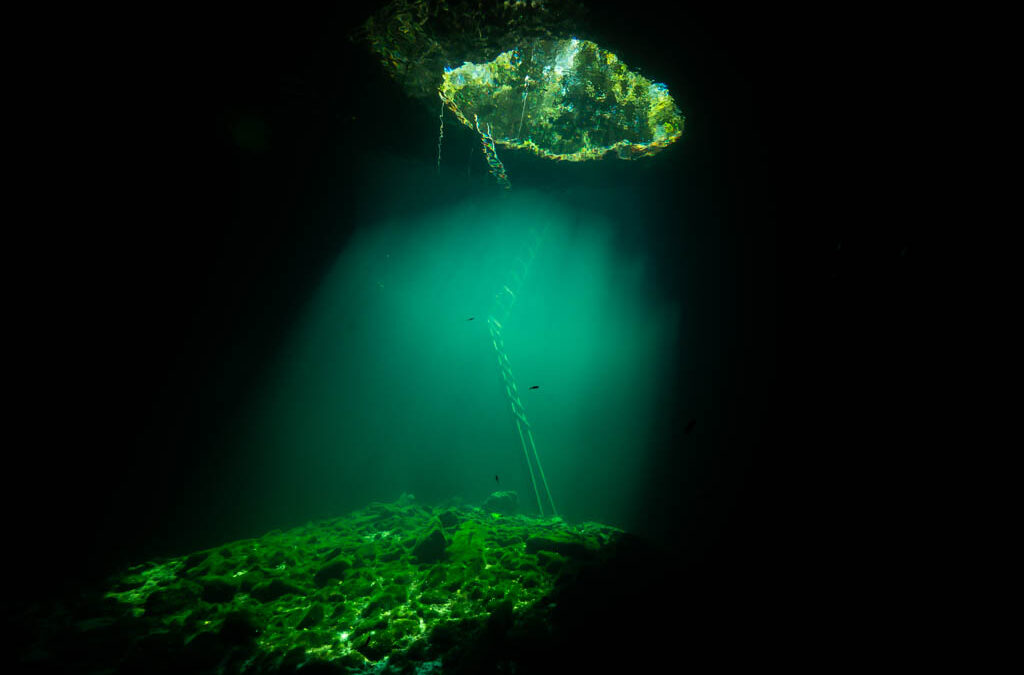
Cenotes:
Dives: 3
Difficulty: Hard
Suitable for: Advanced
Features:
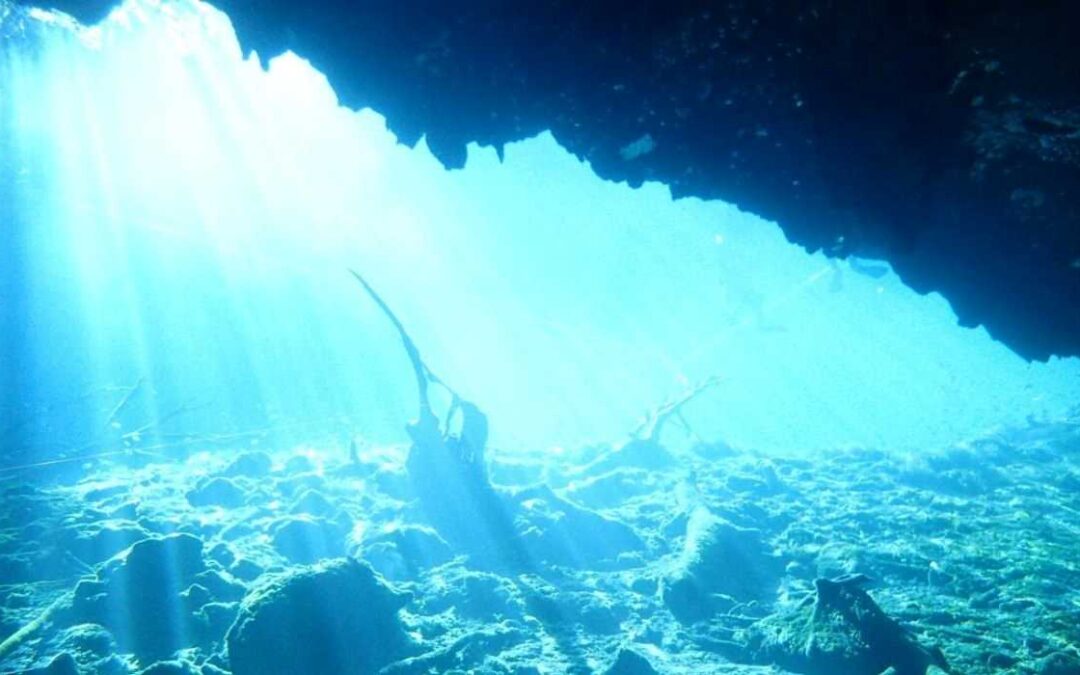
Cenotes:
Dives: 2
Difficulty: Intermediate
Suitable for: Open Water
Features:
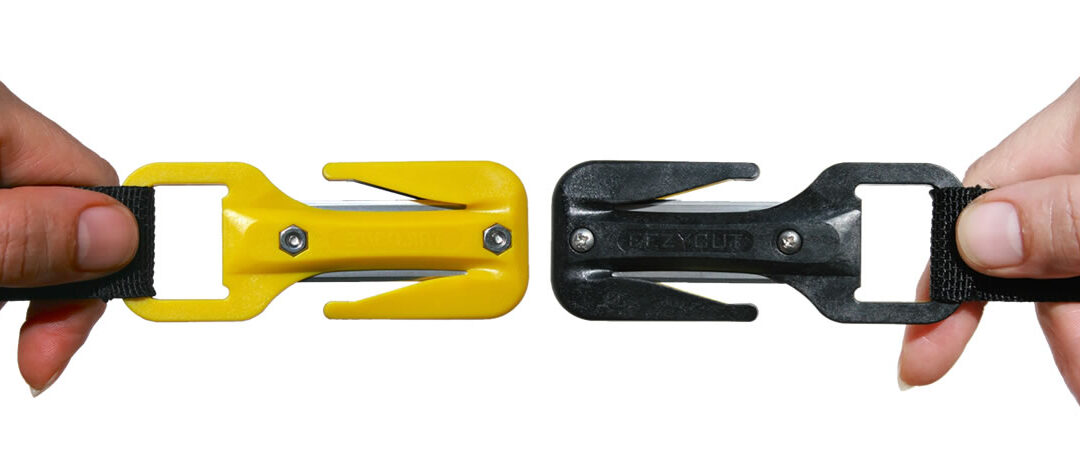
All divers should carry, at least, one kind of “Line Cutting Device.” That can be a Scuba Diving Knife, Scuba Sheers/Scissors or a Line Cutter.
In the unlikely event that a diver finds themselves entangled in fishing line, net or another kind of line underwater, they can cut themselves free to reach safety.
The diver might have to cut through the line or thing causing the entanglement or, as a last resort, they may have to cut themselves out of their equipment.
The knife should be accessible with both hands because if one hand is entangled you will have to reach the knife and cut yourself free with the other one.
Technical divers should carry two line cutting devices.
The best dive knife is a tool, not a weapon.
The Best Diving knife was made famous in all those James Bond films where he has a Dive Knife with a leg strap. It comes in useful fighting against all those villains. But we don’t use them for stabbing people. So most divers now prefer smaller more compact cutters because there is less chance of accidentally cutting yourself or your gear.
Spear-fishermen often use big dive knives but they are skin diving knives for cutting up fish. Proper divers don’t kill the fish they are going to watch.
Modern Diving knives often now come with a few different tools that can be useful. They often have a small line cutting hook and some can be used as a screwdriver.
They are a useful tool but not as useful at cutting line as some other tools.
Diving Sheers or Diving Scissors are great. The scissor mechanism provides leverage to cut tougher lines and it keeps the sharp blades safe. They are very cheap when compared with dive knives. The only downside is their size they are quite bulky so can’t slip into a sheath on your wrist or leg. It is best to store them in a pocket.
Modern compact Line Cutters are the technical tool of choice when it comes to line cutting devices. The small compact shape and easy to use sheath can be mounted on your wrist, shoulder or waist very easily. They are easy to access and easy to use. They have a razor-sharp blade that is easy to change when it gets blunt but are protected by its clever design so its virtually impossible to cut yourself.
I want three things, I want it to be;
Titanium blades are sharper but they are more expensive. They often have the pointy ends whereas the stainless steel blades are a lot cheaper and have the blunt tip option.
A blunt-tipped dive knife is best because it is safer. There is less chance of accidentally stabbing yourself or your equipment if it doesn’t have the pointy end. Remember the dive knife is a tool to cut yourself free. It’s not really for stabbing things or people, even if they have split fins and are kicking the coral.
The blunt tip can also be used as a screwdriver which can be a useful tool to have handy underwater or at a dive site.
The best scuba diving knife in the world is the EEZYCUT Trilobite. It is compact and comes in a small easy to use sheath so that it can fit comfortably on your wrist, shoulder or belt strap quite easily. The ingenious design protects the sharp edges of the blade which means that it is very difficult to accidentally cut yourself or your gear. The v shape of the blades means that it cuts through line and straps with ease.
The best titanium and folding knife is the Saekodive Folding Titanium Scuba Knife. It is small enough to be able to fit in your pocket. The titanium blade is exceptionally sharp and the line cutter is convenient. It folds away safely so it doesn’t cause any damage in your pockets.
The best scuba sheers are EMT Scissors Shears they are cheap and they work. EMT’s use them all over the world to cut clothing off victims. The scissor action means that they are much easier to cut line than a knife or line cutter.
The Cressi Versatile Dive Knife is the best Cressi Dive knife. It comes with either a blunt tip which is safer for divers and can be used as a screwdriver, Titanium, which is sharper, Spear which is longer and sharper or Black, which yes you guessed it is black and sharper. Divers should get the blunt nose it is much safer.
The best Promate diving knife is the Promate Barracuda Blunt Tip. It’s a good solid knife that comes with a cool leg strap.
The Best Tusa dive knife is the Imprex X-Pert II it is sharp and it straps to your leg.
The best Mares diving knife is the Snake Spearfishing Knife. It is a great skin diving knife. It’s good for stabbing things.
The best ScubaPro Dive knife is the ScubaPro Mesh Cutter. This is a great little alternative for a line cutter.
If you are after a big knife look no further than the Cressi Giant Knife. It is the best dive knife with a leg strap so you can look just like James Bond or Rambo.
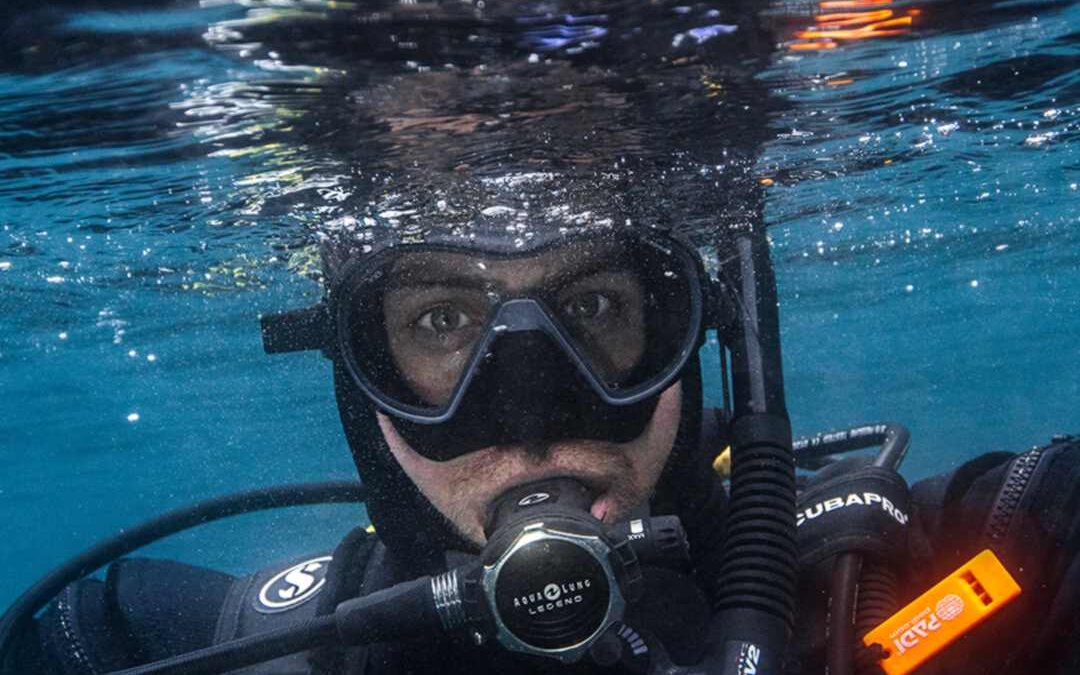
The Best Scuba Diving Mask is the Mask that keeps the water out of your eyes. They have been designed to withstand the pressure underwater.
The glass of a scuba diving mask must be “Tempered Glass” to resist the higher pressure. If it does break, it will break in small pieces that won’t cut, like car glass. But to be honest, in 5 years I have never seen glass breaking. To be sure the lens is made of tempered glass the word “Tempered” or the letter “T” must be inscribed on the glass.
The skirt of the mask must include the nose. We can’t scuba dive with swimming goggles. This is so you can equalize the pressure in the air space formed by the mask. Failure to equalize this pressure can cause a mask squeeze.
The skirt should be made of silicone. There are a few reasons for this, the comfort, dryness and the seal on your face. Today most of the skirts are made of silicone, or even “Crystal silicon” which is more comfortable, more silky, more …. Cheaper rubber masks will feel harder on your face, are more likely to let water in and will not last as long. An underskirt gives better adhesion to your face and prevents small drops of water leaking into the mask when you smile for example.
The Best Dive Mask for Scuba Diving is the one that fits your face well. Everyone has a different face, so the right mask for you isn’t necessarily the best mask for me. The only way to find the best mask for you is to try them on. It should be comfortable and give you a good field of vision.
The Best Dive Mask for Scuba Diving for me is the Aqualung Micro Mask. But it might not be the best mask for you as I assume you have a different face to me.
To have the optimal field of vision you have to remember that the mask with the biggest glass is not necessarily going to give you the widest field of vision. We also have to consider the distance the glass is from your eyes. A larger single glass lens can give you a narrower field of vision than two smaller lenses that are closer to your eyes.
Thinking about this, I choose a really low profile mask, as I prefer a small lens close to my eyes. This means there is less refraction (magnification) of objects underwater, it’s much easier to clear water from a low volume mask than a bigger one and it gives me a wide field of view, but still with small glass lenses.
About the debate between transparent or opaque skirt. For me, there is no question. The skirt must be opaque, and this is for one simple reason. Transparent skirts let light in at the side, the reflection on the glass can be very annoying. I already have this problem with my reading glasses, I don’t want to have this glare in my mask when I scuba dive. So for me, the transparent skirt doesn’t even exist.
Choosing your first scuba diving mask for your scuba equipment can be a difficult process. You find yourself in front of a wall with 100’s of masks that can seem all the same. This is why today, I have decided to explain how to choose the right mask for you.
To start you have to know that I have spent more time in a scuba diving shop trying on masks and looking at all the new gadgets, than in clothes shops trying on the latest fashions.
A Scuba Mask costs about $30 – $150
A low volume dive mask is a mask that rests closer to the face. The internal volume of the mask is lower when compared with a standard mask. As it has a lower volume it reduces the pressure on the face. As the glass rests closer to the face the field of vision is often better.
A frame-less dive mask is a mask that has been designed without a hard plastic frame. They are more flexible which means that they can flex to fit your face better, fold up and go in your pocket and they are less likely to break if you sit on them.
Polarized dive masks are dive masks that have a tint on the outside so they look like cool sunglasses. The disadvantage is that other divers can not see your eyes.
If a diver is panicking the correct response is to make physical contact with the panicking diver. Then you get them to look into your eyes. Your calm reassuring eyes take away the panic. Of course, if you are wearing a polarized mask that does not happen, instead of seeing your calming and reassuring eyes they see themselves in a mirror panicking which inevitably cascades the panic.
So if you want to look cool great. I would rather be safe than looking cool because being safe is the coolest thing you can do whilst scuba diving.
This is a difficult subject, as each mask is different but whichever mask you buy, all-new masks need a treatment inside the glass to take off a silicon layer that is left on during fabrication in the factory. There are different ways to take this layer. The best scuba diving mask defog techniques are as follows.
Take a lighter, pass the flame on the inside of the glass. Be careful to not burn the skirt. You will see the layer burning off. Once the glass is all burnt, you’ll see black marks on the lens, wait for it to cool down and wipe off the black char.
Choose a simple toothpaste, put a small dab on the inside of the lens, rub it around to cover the all-glass evenly. Let the toothpaste dry, generally, I leave it overnight or until I need to use the mask again. It could be a few days or weeks, but months should be fine. When I need to use it I clean it with fresh water and take off all the residue, remember that if it gets in your eyes it can sting, but it does give you minty fresh eyes.
I read somewhere while preparing this article, that you can buy an “industrial” product to take of this silicone layer. As I never used it, and as I don’t want to miss lead you, I decided to not speak any more about this.
If you want, like my husband, you can burn your mask before each dive, or toothpaste it after each day of diving to prevent the fog from forming.
But always remember before each dive use your saliva or “anti-fog” product. Similar to the toothpaste, spit or spray “anti-fog” product on the inside of the lens. Rub it so it covers the whole glass. Rinse it with water before diving. This leaves a protective layer on the glass that prevents fog forming.
Whatever you decide to do, remember that all masks, environments, and people are different. My husband and I use the same mask, his mask seams to fog more than mine does. This is why he started to burn it before each dive. For my part, I burn my mask every 6 months, or when I dive with husband and see him doing it. For the same reason, you will never really know how a mask fogs before buying it and using it.
After diving it’s important to clean your mask with fresh water. Salt and other contaminants that dry on the mask will cause damage over time. Pay particular attention to the silicone skirt, buckle and strap as these areas will wear and split if not cared for properly.
It’s time for you to go and find the mask for you, like a professional, in your local scuba diving shop.
If you want to know which mask my husband and myself choose. We fell in love with the “Micro-mask” from “Aqualung”. We have sworn by this mask for the last 4 years. It’s really low volume give us a really good field of view, and clearing it when water gets in is easy. We love it so much we have a back up one untouched in his box just in case. The best scuba diving mask is….
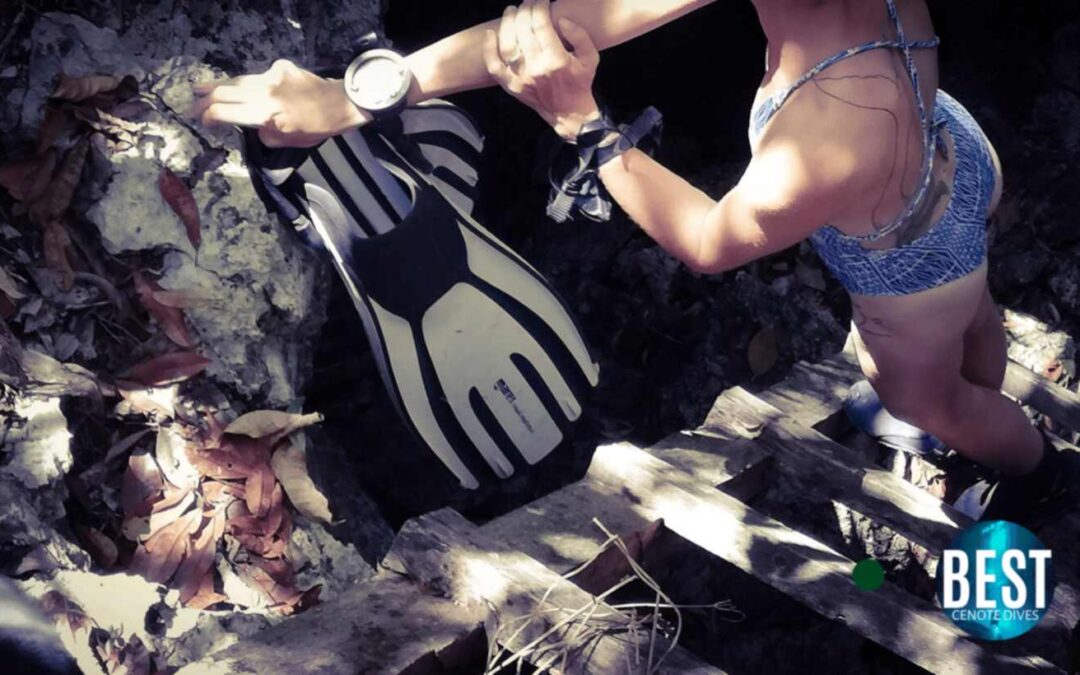
What are the best scuba diving fins depends on the job that you want them to do. Depending on the environment you are diving in and your equipment configuration can influence what fins you go for.

The Best Diving Fins for recreational scuba are the Mares Avanti Quattro. A long time ago Mares made the best fins ever for recreational scuba. It is the best product out there for the job. #AD

The Best Cave Diving Fins are the Dive Rite XT. The Mares work fine in a cave but some people prefer a slightly heavier firmer fin in the cave environment. It can help reduce silt disturbance, give better power and be easier when scootering. #AD

The Best Technical diving fins are the OMS Slipstream. The broader fin provides more power and better stability when carrying many tanks.
How to choose the Best Scuba Fins
Total Time: 1 minute
If you are a recreational diver and you love the fish and coral in the sea. If you are happy with one tank and you have no interest in going deep, into wrecks or into caves. You should buy the Mares Avanti Quattro fins. They are the best scuba fins for you.
You should buy the Mares Avanti Quattro fins. They are the best scuba fins. Seriously, for warm water entry to tech and cave, the Mares are great.
If your Quattros are too floppy and you want something more rigid you should buy him Dive Rite XT.
If you find that your feet go up when you are diving you are in negative trim. You need to lower the position of the weights on your body. If that doesn’t work you need to get a heavier style of a fin, like the ScubaPro Jet Fin.
We use best scuba fins for diving because they give us more propulsion in the water. When we are carrying all our gear it is impossible to move very far or very fast without them.

The Mares Quattros are the best diving fins because they are powerful, reliable and easy to use.
In warm water, some divers go for closed heel fins. It’s cheaper because it avoids the need for boots. In cold water, you need the boots to keep your feet warm so you get the open heel fins and boots. It is much easier to put open heel fins on, especially at the back of a rocking dive boat. So dive schools use closed but if you buy get open with boots its much better.

No, they are not please don’t buy split fins. They have a silly split ruining down the middle. This causes excessive and unnecessary water movement and it’s impossible to back fin so you can’t really hold a good trim position. They are crap please ignore the very nice salesman in the shop who is trying to convince you that they are great. They aren’t. Buy the Quattros, please.
I said at the beginning Mares made the best fins for recreational scuba diving a long time ago. All the competitors have gimmicks that they think make their fins unique and better, but they aren’t. Mares fins are the most popular fins with diving instructors for a reason. They work better.
No, it doesn’t matter if you call them scuba diving flippers. You sound a bit silly, but not much more silly than the people that call their dive boots, booties.

If you aren’t sure which is the best fin to buy you should buy the Mares Avanti Quattro. They are the best.
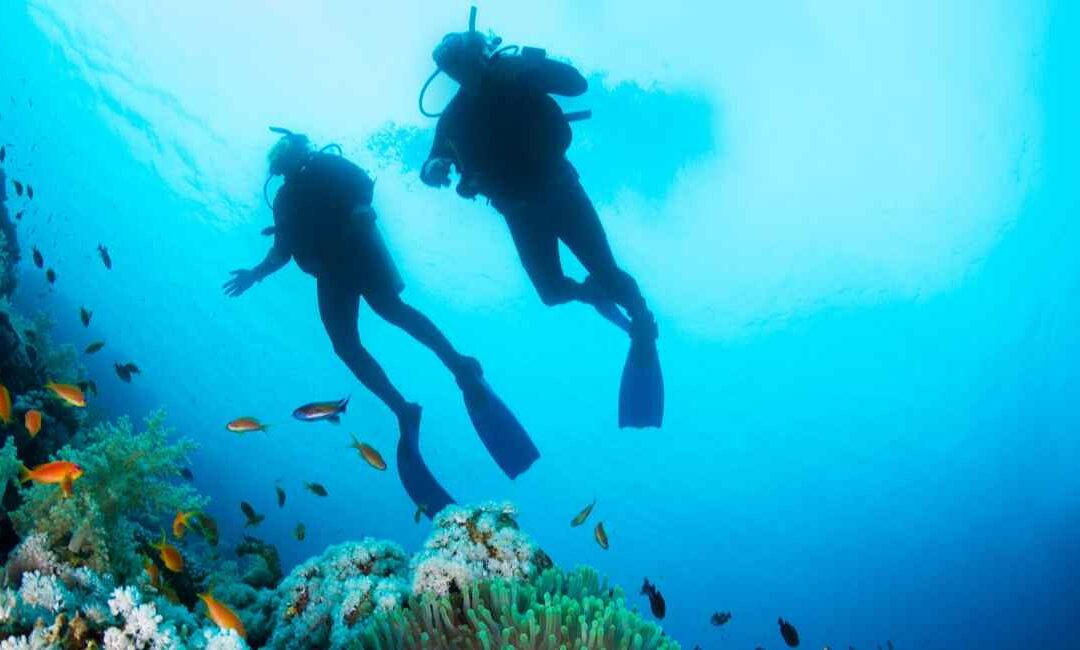
A dive computer is a small wrist or console-mounted electronic device that displays at a minimum a divers depth, time and no-decompression limit.
A device that measures a divers’ depth and time is known as a depth-timer.
The best dive computer watch measures the depth with a pressure sensor. It doesn’t measure your depth in water. It measures the ambient pressure and then calculates the depth based on the pressure. The timer is like a timer. Then the No decompression limit is calculated by applying the depth and time throughout the dive to an algorithm.
Recreational diving is also called, no decompression diving or no stop diving. That means that in an emergency a diver should be able to ascend to the surface, slowly, without doing a safety stop and be reasonably assured that they won’t get decompression sickness. The deeper a diver goes the shorter the no-deco time. The computer can keep track of the different depths a diver is at and how long the diver has been there.
When we use dive tables we plan the dive as if we were at the maximum depth for the entire duration of the dive which is rarely true. We often plan to do the deepest part of the dive first then work shallower as the dive progresses. The computer eliminates unnecessary rounding and gives us a much more accurate No deco limit.
There are some things which now come as standard on dive computers. It’s always important to read the manufacturers instructions to check how they all work.
It will have a way of indicating if you are ascending and it should alert you if you go to quick.
As you ascend to 5 m towards the end of the dive. It should display a safety stop and indicate once 3 minutes have passed so you know its safe to go up to the surface.
On the surface, you should have the facility to check the no-decompression limit for a depth. It should factor in any previous dives.
It should keep a record of dives so you can check back.
Most computers have the ability to change the percentage of oxygen when calculating the no-deco limit. Check out the Nitrox course here.
The Best Diving Computer for recreational diving is the Suunto Zoop.
I think it’s the best recreational scuba diving computer because it does all of the core functionality really well, It has a big clear display that is highly visible in all environments, it is tough and stands up to a lot of bashing about and it’s a great price.
What is the best Technical Diving Computer?
The Best Technical Diving Computer is the Sheerwater Perdix.
It has a beautifully designed and easy to read display, excellent functionality and durability. The customer service from Sheerwater is the best.
Technical divers change gas mixes during their dives so they need to have the facility to be able to change the gas mixes on the computer. Also due to the higher level of training involved in technical diving, technical diving computers often have the option to change the algorithm making them often less conservative than standard computers.
I much prefer a wrist-mounted computer to a console-mounted one. I find it easier to see on my wrist. Console mounted computers are “air integrated” so they read the air as well. This can be a disadvantage as if the computer fails you know your gas as well as your depth, dive time and no-deco limit.
Some computers come in more of a watch style so they can be worn at work and leisure as well as whilst diving. They become a secret signal amongst divers. I remember always nodding to fellow divers when I saw that they were wearing a distinctive dive watch. Here are some great recreational diving computer watches.


Now I´m going to go through the individual manufacturers and say which one I think is the best for each brand.
It is the Zoop.

It is the Oceanic Geo 2.0

It is the Mares Smart

It is the Cressi Leonardo

It is the Sheerwater Petel

It is the Cressi Leonardo

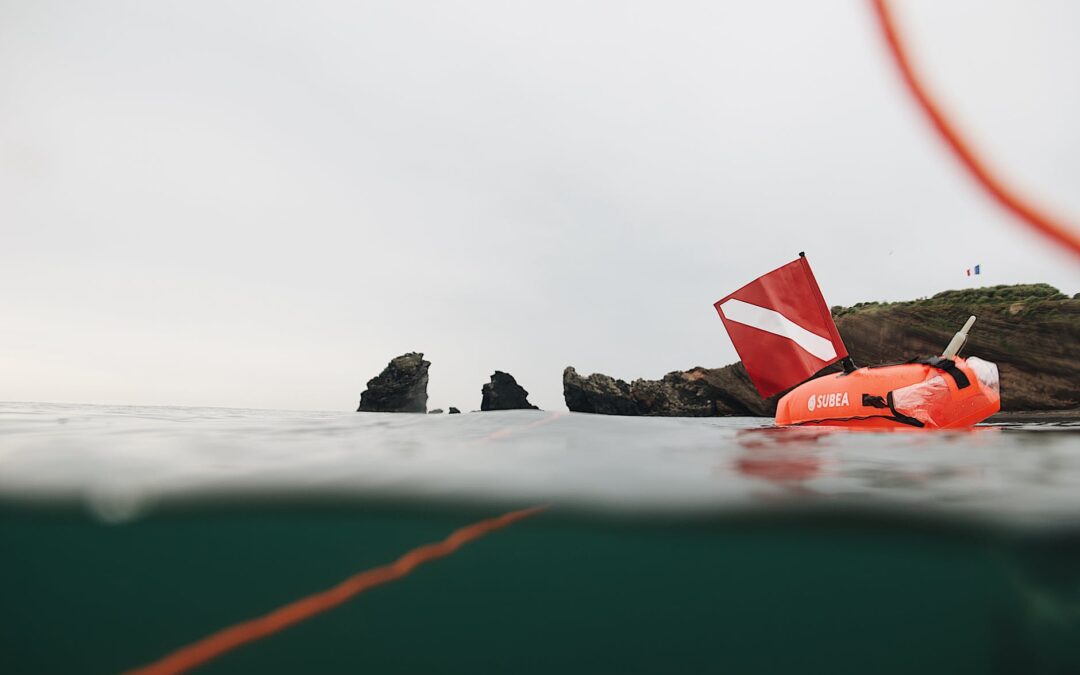
Scuba diving equipment is the equipment we use to be able to breathe underwater. It stands for Self Contained Underwater Breathing Apparatus. So SCUBA Diving is going underwater whilst breathing on this SCUBA gear.
The breathing equipment we use to dive consists of,

A diving tank or a scuba cylinder is the first thing you think of when you think about scuba diving equipment. It is made from Aluminium or Steel. For recreational diving, we often use 80 cft / 12 l tanks. 80 cft / 12 l refers to the external volume of the tank. The tank contains compressed AIR, just normal air that we breathe on the surface. It is NOT (every single journalist in the world please take note here) Oxygen. That would be extremely dangerous. The AIR is compressed to 200 atmospheres of pressure. That’s 200 times the pressure about you now which is about 3000 psi.

It’s called a regulator because it is a pressure regulator. It regulates the high pressure in the tank down to nice safe ambient pressure, which is the pressure on the surface or the pressure at any depth you can safely dive. 40m max for recreational diving.
It’s called a scuba octopus because it looks like an octopus. It has a 1st stage made of metal and lots of tentacle-like arms coming out. At the end of two of them are mouthpieces to breathe from. A primary and a backup. One has a pressure gauge to read the tank pressure and the other connects to the BCD.

A BCD securely attaches to the tank and then the diver and has a bladder that can be inflated to help a diver stay on the surface, deflated to allow the diver to sink and adjusted underwater to enable the diver to stay still. You can get smaller travel bc’s, bigger jacket styles and harnesses, which have a backplate and wing style inflation system. Most divers learn with a jacket style BCD, however, the backplate and wing style is better because it holds the body in a horizontal position whilst underwater.
So that’s the Self Contained Underwater Breathing Apparatus.
To remember what equipment I need to go diving I always imagine I am standing by the edge of the water and I am about to jump in. I look at myself from the bottom up and go through all my scuba gear.

They are the flappy, paddle, finny things that go on your feet. When you kick your feet you go faster in the water. You can get closed heel scuba fins or open heel scuba fins. The closed heel fins are good for warm water but in cold water, you need scuba boots to keep you warm so you should get open heel if you think you might do cold water diving.

Boots that go on your feet made of neoprene to keep your feet warm.
A wetsuit that is thick enough to keep you warm in the environment you are diving. Too cold can be dangerous and too hot can be dangerous too so it is important to get the right suit for the job.

Warm water. 3-5mm Neoprene full-body wetsuit or shorty wetsuit. Some bigger guys will go with nothing. Yes, you know who you are.
Coldwater. 5-9mm Neoprene wetsuit or Dry Suit.
Whether it’s cold or warm isn’t just about water temperature, (General about 60-77 Fahrenheit, 15-25 Celcius) can vary based on an individuals body type, metabolism, time spent in the water, temperature out of the water, the temperature at depth, number of dives. In my experience, it’s better to be a bit warmer.

Are attached on a weight belt or are integrated into the BCD if it has an integrated weight system. You may not need weights you certainly don’t need too much.
There is more about diving computers here.

On my head, I have a Diving Mask or a Scuba Mask. Its rubber has a strap that goes around my head and a glass window so I can see where I am going.
So that’s the absolute bare minnimum equipment you need to go scuba diving with. But there are other bits of scuba gear that you should seriously think about getting.

Snorkels are great if you spend a lot of time on the surface in big waves where you might have to swim or wait for a boat. I spend most of my time diving in a cave so we leave the snorkels on the surface, but they are great when we are exploring new Cenotes and dont want to carry a big tank.

Usually wrist mounted but can be mounted on a console or just clipped on. It’s useful to tell which direction you are going in and how to get back.

It’s a Delayed Surface Marker Buoy. Usually, red, orange or yellow it looks like a long sausage, so they are sometimes called safety sausages, about 6 ft / 2 m long. We usually attach them to a reel of line, inflate them and send them shooting to the surface. They alert nearby boats that divers are coming to the surface. If you are lucky your boat captain recognizes your DSMB and is waiting for you close by on the surface when you come up. You have to be careful with these that you don’t get pulled up with them.
A whistle can be a useful device in an emergency.

Great for seeing in the dark or low visibility. They can also be used for communication if you know how.
Technical Diving Equipment must offer what we call “redundancy.” What that means in diving is that we must have two separate systems for breathing on, so that if we have a failure with the first we can switch to a backup system. Either;
Back-mount Technical diving is done with two tanks attached, with tank bands and a manifold system which has an isolator valve on it. Each tank has a separate regulator system on it. That is then strapped to the back of the diver with a harness. The isolator valve is usually kept open during the dive and if there is a gas leak the diver can close the valve and save half his gas.
Back-mount is better for Deep Sea diving in big spaces.
Side-mount Diving is where the dives has two tanks mounted on each side of the body. The tanks aren’t connected so they offer the diver a completely redundant system but the trade off is that the diver has to switch gas during the dive, such that if there was a gas leak they would save at least half the gas.
Side-mount is better for Caves and small spaces.
Technical divers will often carry additional tanks of gas with them and they will usually have a variety of funky gas mixes to breath from.
Some technical divers use a CCR or closed circuit rebreather system. That’s a whole different level of diving that requires a whole new set of scuba diving equipment.
You don’t need to buy scuba diving equipment. Most dive shops have dive gear to rent, so you can do your course and go diving all around the world without having to buy any gear. However having your gear is nicer. It will probably be better quality and more reliable. All gear is slightly different so you would need to used to the different gear at different places. Somethings like a dive mask, it’s best to get your own.
You can buy scuba dive gear from your local dive shop, online or second hand. Amazon has some great deals here.
It is better to have your own gear. You will learn how it works better over time as it’s more familiar and when you buy gear you generally buy a better standard than the local dive shops scuba diving equipment for rent.
Best Scuba Diving Regulators – Apeks MTX-R
Best Scuba BCD – Scuba Pro X Black
Best Scuba Fins – Mares Avanti Quatro
Best Boots – Bare 7mm Ultrawarmth Boots
Best Scuba Wetsuit – Aqua Lung SolAfx
Best Scuba Diving Mask – Aqua Lung Micro Mask
Best Dive Light – Big Blue AL1200
Best Diving Computer – Suunto Zoop
| Scuba Tank |
| Scuba Regulator |
| Dving BCD |
| Scuba Fins |
| Dive Boots |
| Wet suit |
| Scuba Weights |
| Diving Computer |
| Dive Mask |
| Snorkel |
| Dive Compass |
| Scuba DSMB |
| Dive Light |
| Dive Knife |
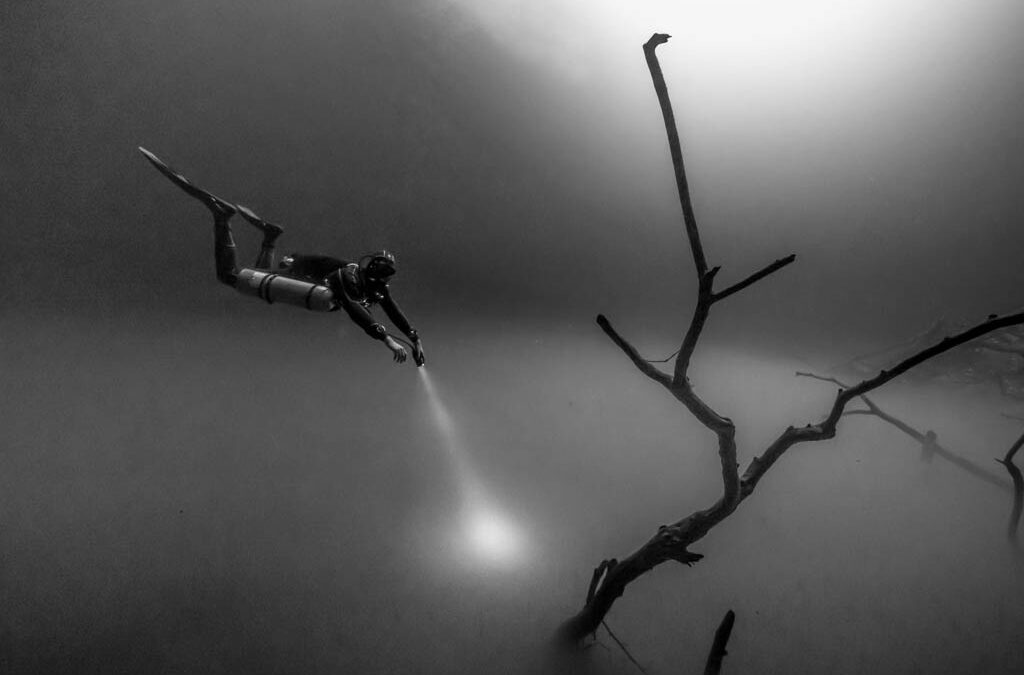
Angelita Cenote means “Little Angel” in Spanish. Of all the Cenotes we dive Cenote Angelita in Mexico stands out as the most completely different dive. Most divers say that it is the most memorable Cenote dive we do.
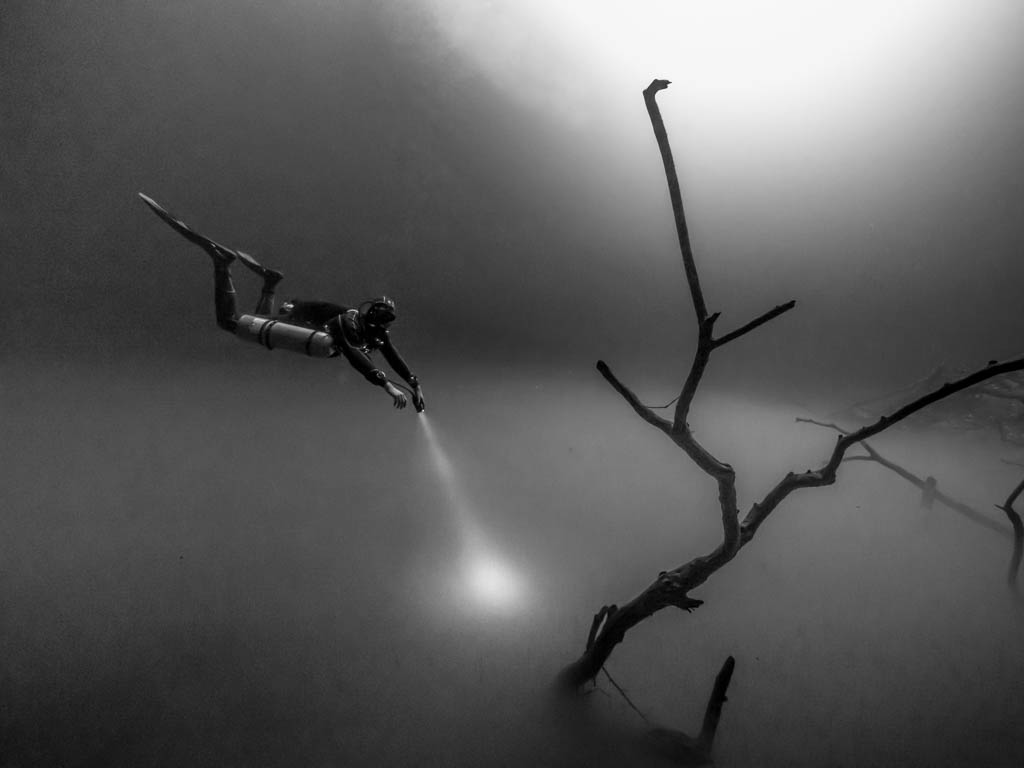
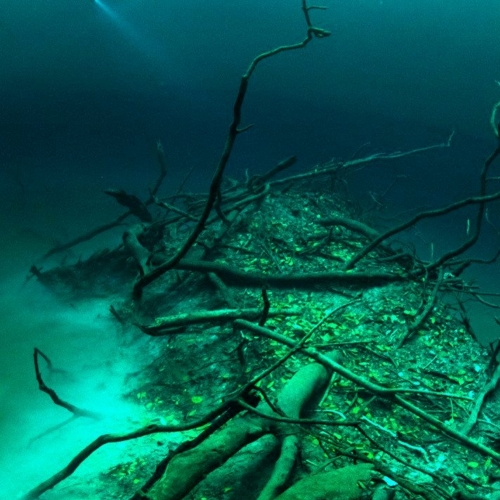
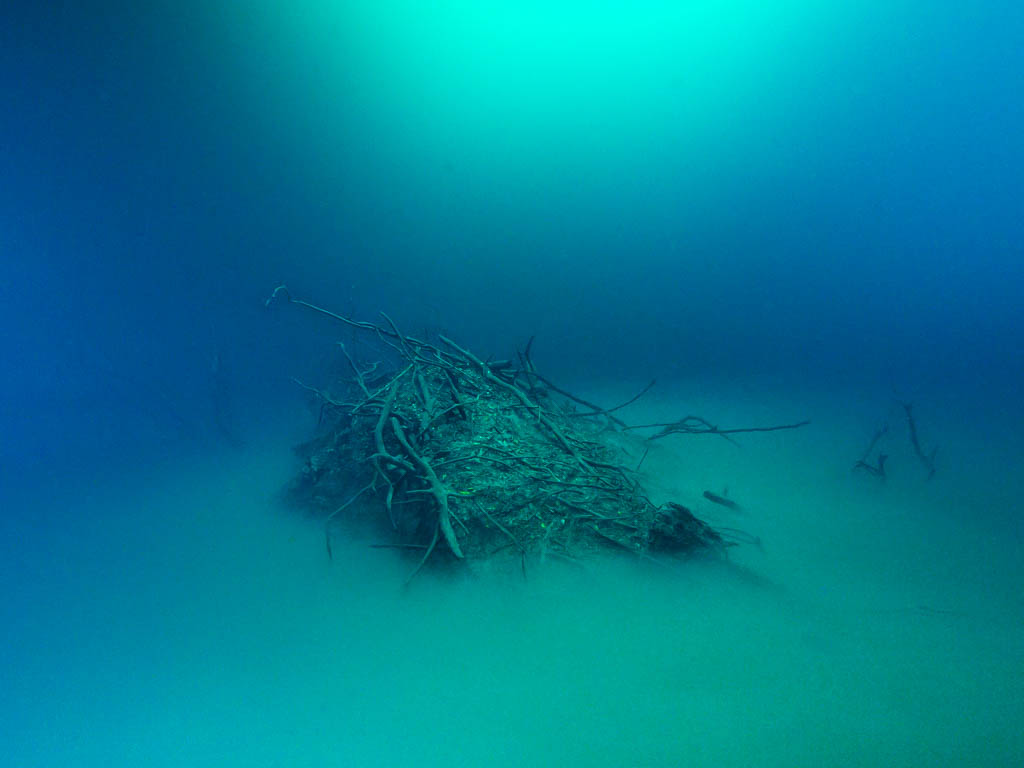
Most of the Cenotes in the Riviera Maya have a nickname. The nickname of the Cenote Angelita is “The Nightmare” It’s a serious dive and due to the depth, you need to have an advanced certification.
Cenote Angelita is located near Tulum, about 15 mins drive to the south. A short walk through the jungle from the car park brings us to a large lake of water.
Angelita Cenote is a cylinder that goes down. It differs from other Cenote dives as when the Cenote was formed, the collapsing roof has blocked the connecting cave passages. So there isn’t the same water flow as at other Cenotes.
Angelita Cenote has a Maximum Depth of 56m. However, the maximum depth for recreational divers is 40m, so you must have technical dive training to exceed a depth of 40.
The lack of flowing water affects visibility. From the surface, we can’t see down to the main feature of the dive site. At 30m a thick cloud of Hydrogen Sulfide Gas.
Caused by all the vegetation that falls into the Cenote, rotting at depth causes the organic material to produce a white smokey gas that hangs in the water. It is a poisonous gas so it’s best not to drink it.
As we descend from the surface it’s not until about 15/20m that we start to see it. Emerging out of this thick swampy cloud an island of rocks that have fallen in from the roof. Dead tree branches resting on to give it an ere feeling. We gather together and prepare to descend through the cloud.
The cloud is 3m thick, visibility goes down to less than half a meter. We get through this bit as quick as we can because underneath the visibility is much better, but dark. It black like a night dive. Dead trees litter the bottom slope that disappears off down to 56m. We go to 40m Max. Then we slowly work our way back up to the cloud.
Passing through, going up is the most awesome thing about this Cenote dive. Visibility is next to nothing but then as we come up the cloud appears as thin wispy lines in the water, it’s very cool. Just on top of that a halocline. A change from salt below to fresh above creates cool light effects which add to the experience.
Above the cloud, we explore this eerie landscape. The cloud-like a swamp below us the island of rocks to the side as we glide through fallen tree branches. The island provides a haven for fish that live just above the cloud.
Being careful not to let our time get too low, it’s time to leave. Coming into the side of the cylinder we begin our nice, smooth, multi-level ascent to the surface. A small swim through passage brings us out amongst some interesting stalactite features. Under an overhang at 5m, we see big bulbous stalactites with rough edges. Interesting things to look at during ascent. But by far the most awesome feature is the cloud, so we maximize the time there.
During the safety stop, we can look up to see the overhanging jungle trees with the beautiful light coming through. It’s all just so magical and enchanting that most people say this stands out as the most memorable Cenote experience. Due to the challenge of the dive, it’s not recommended for the first day, best to get accustomed to this environment at an easier dive site first.
Cenotes vary in depth from very shallow to very deep. The deepest Cenotes in Mexico by the Quintana Roo Speleological Survey.